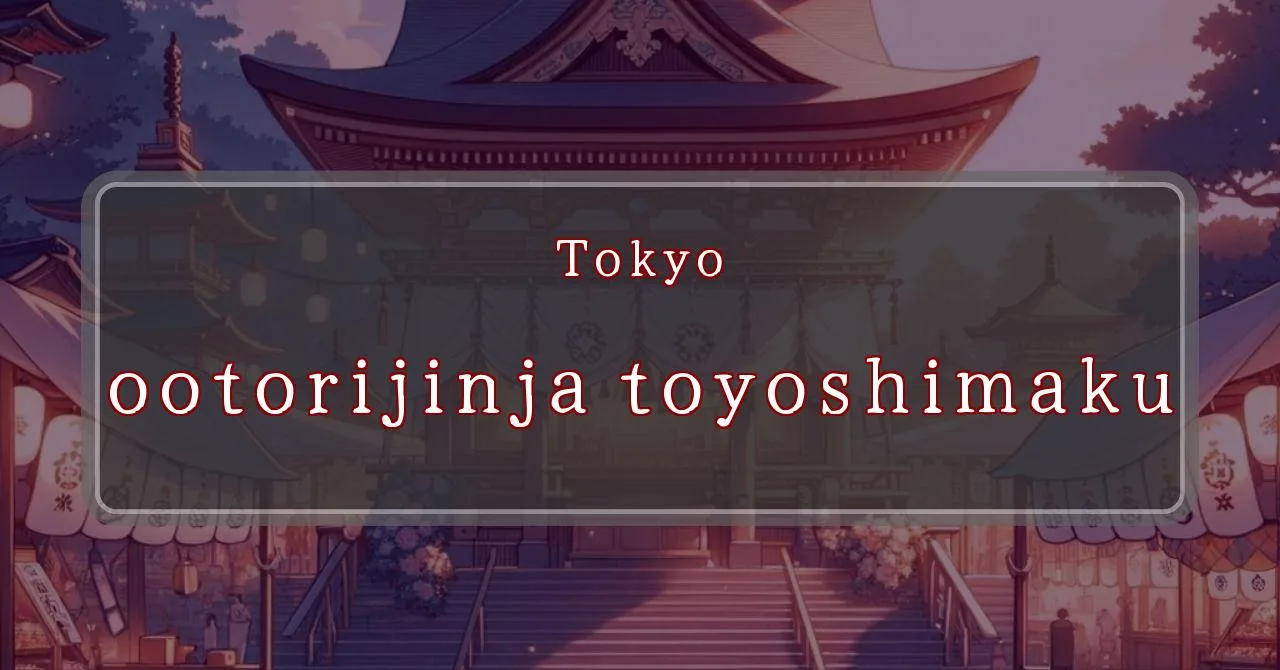Enchanting Shrine Festival in Toshima, Tokyo
Basic Information
Ootori Jinja Shrine is a Shinto shrine located in Toshima Ward, Tokyo, Japan. It is dedicated to the god of war, Hachiman, and is one of the most popular shrines in the area.
- Address: 3-20-14 Zoshigaya, Toshima-ku, Tokyo 171-0032
- Phone Number: 03-3971-6034
- Access: A two-minute walk from鬼子母神前 Station on the Toden Arakawa Line, or a four-minute walk from雑司が谷 Station on the Tokyo Metro Fukutoshin Line.
- Festival Days: September 14th (Sat) and 15th (Sun), 2024
Main Events and Attractions of the Festival
The Ootori Jinja Shrine Festival is a two-day event held annually in September. It is one of the most popular festivals in Toshima Ward, and it attracts visitors from all over Tokyo.
Mikoshi Procession
One of the main highlights of the festival is the mikoshi procession. On both days of the festival, a portable shrine is carried through the streets of Zoshigaya by a team of men. The procession is accompanied by music and dancing, and it creates a lively and festive atmosphere.
Kagura Performance
Another popular attraction of the festival is the kagura performance. Kagura is a traditional Japanese dance that is performed to Shinto music. The performance tells the stories of the gods and goddesses of Japan, and it is a beautiful and moving experience.
Food Stalls
There are also a number of food stalls at the festival, selling a variety of traditional Japanese dishes. Visitors can enjoy yakitori, takoyaki, and other festival favorites.
Bon Odori Dance
On the evening of the second day of the festival, there is a bon odori dance. Bon odori is a traditional Japanese folk dance that is performed during the Obon festival. Visitors are welcome to join in the dance, and it is a great way to experience Japanese culture.
Blessings and Deities
Ootori Jinja Shrine is dedicated to the god of war, Hachiman, and the god of agriculture, Inari. Hachiman is one of the most important gods in the Shinto pantheon, and he is revered for his strength and courage. Inari is also a popular god, and he is worshipped for his ability to bring good fortune and prosperity.
- Hachiman: God of war, strength, and courage
- Inari: God of agriculture, prosperity, and good fortune
Origin and History
The origins of Ootori Jinja Shrine are unclear, but it is believed to have been founded in the 17th century. The shrine was originally located in a different part of Toshima Ward, but it was moved to its current location in 1887. The shrine has been rebuilt several times over the years, most recently in 1981.
- Founded: 17th century
- Moved to current location: 1887
- Rebuilt: 1981
Tips and Notes for Visitors
Here are some tips and notes for visitors to Ootori Jinja Shrine:
- The shrine is open from 9:00 AM to 5:00 PM every day.
- Admission is free.
- There is a small parking lot available for visitors.
- The shrine is a popular spot for weddings and other ceremonies.
- There are several restaurants and shops in the area surrounding the shrine.
Parking Information
There is a small parking lot available for visitors to Ootori Jinja Shrine. The parking lot is located behind the shrine, and it can accommodate about 20 cars. The parking fee is 500 yen per day.
Popular Stalls and Food Carts in Recent Years
| Type of Stall | Description |
|---|---|
| Takoyaki | A staple at Japanese festivals. Characterized by a crispy outside and a creamy inside. |
| Jaga Butter | A simple yet popular snack of hot potatoes lavishly topped with melted butter. |
| Baby Castella | Small castella cakes, sweet and fluffy treats enjoyed by children and adults alike. |
| Grilled Ayu with Salt | Fresh ayu fish grilled whole with salt, a savory taste of Japanese summer. |
| Shaapin | A unique gourmet item influenced by foreign cuisine, with a chewy skin wrapping the filling. |
| Okonomiyaki | A Japanese grilled dish where you often choose your own ingredients for a personalized flavor. |
| Cotton Candy | A fluffy, sweet snack that’s extremely popular with children. |
| Chocolate Banana | A banana coated in chocolate, a fun and visually appealing dessert. |
| Kushiyaki | Various types of ingredients skewered and grilled, an easy-to-enjoy snack. |
| Yakisoba | Fried noodles mixed with a special sauce, a fast food favorite in Japan. |



